-

-
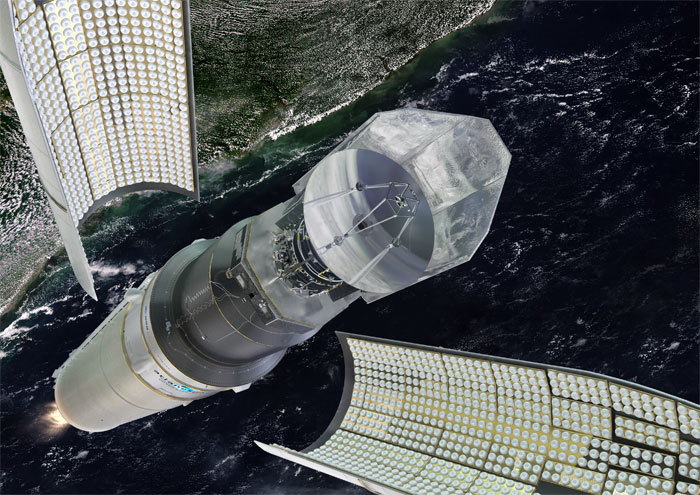
.

Far-infrared image of M 51, the ‘whirlpool galaxy’ at three different wavelengths (160, 100 and 70 microns) , taken by the Herschel Photoconductor Array Camera and Spectrometer, PACS.
These images clearly demonstrate that the shorter the wavelength, the sharper the image — this is a very important message about the quality of Herschel’s optics, since PACS observes at Herschel’s shortest wavelengths.
-
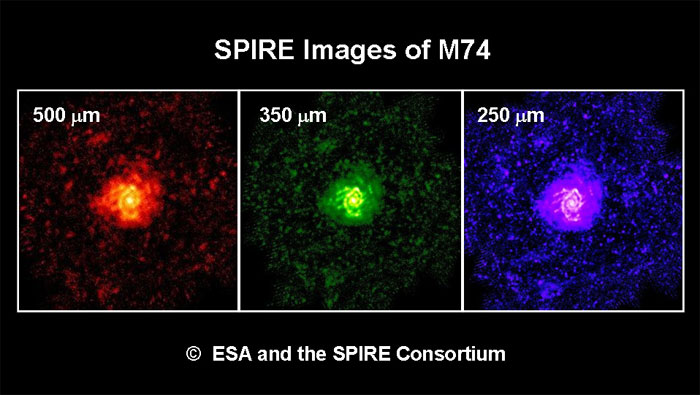
SPIRE images of galaxy M74 at three different infrared wavelengths. These wavelengths are the equivalent of blue, green and red colours in the visible spectrum. The images have been processed to bring out the extended structure of the galaxy and to show more detail in the background sky. The image quality is best at 250 microns because all telescopes produce their sharpest images at their shortest wavelengths. By combining the three images, astronomers can measure the properties of the emitting dust and identify the nature of the many distant galaxies that also appear in the pictures.
Herschel’s primary mirror is 3.5 m in diameter, nearly four times larger than any previous infrared space telescope. These images prove that Herschel enables a giant leap forward in our ability to study celestial objects at far infrared wavelengths. NASA’s Spitzer Space Telescope primarily observes infrared wavelengths shorter than Herschel does, so the two telescopes complement each other.
-
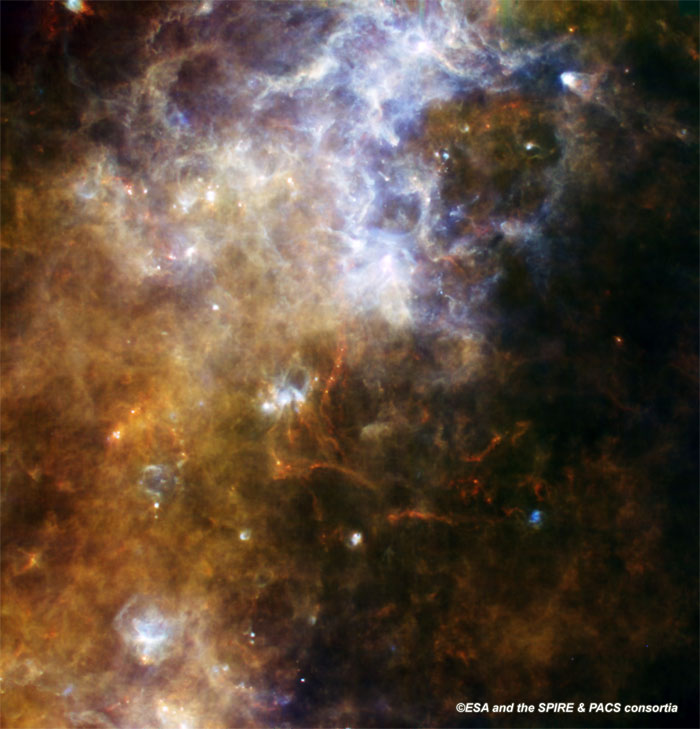
Five-colour infrared image of a reservoir of cold gas in the constellation of the Southern Cross. The region is located about 60° from the Galactic Centre, thousands of light-years from Earth. The images cover an area of 2°x2° on the sky.
The images taken on 3 September reveal structure in cold material in our Galaxy, as we have never seen it before. Even before a detailed analysis, scientists have gleaned information on the quantity of the material, its mass, temperature, composition and whether it is collapsing to form new stars.
That a dark, cool area such as this would be bustling with activity, was unexpected. But the images reveal a surprising amount of turmoil: the interstellar material is condensing into continuous and interconnected filaments glowing from the light emitted by new-born stars at various stages of development. Ours is a tireless Galaxy constantly forging new generations of stars.
Stars form in cold, dense environments, and in these images it is easy to locate the star-forming filaments that would be very difficult to isolate in a single-wavelength image.
Traditionally, in a crowded region like this, situated in the plane of our Galaxy and containing many molecular clouds along the line of sight, astronomers have had a difficult time resolving details. But Herschel’s sophisticated infrared instruments made short work of the task, seeing through the dust that is opaque to visible light, and seeing the glow from the dust itself. These observations are not possible from ground.
The result is a view of an incredible network of filamentary structures, and features indicating a chain of near-simultaneous star-formation events, glittering like strings of pearls deep in our Galaxy.
The five original infrared wavelengths have been colour-coded to allow scientists to differentiate extremely cold material (red) from the surrounding warm stuff (blue).
The SPIRE and PACS images have been combined to a single composite; here blue denotes 70 micron and green 160 micron emission, while red is the combination of the emission from all three SPIRE bands at 250, 350 and 500 microns.
-
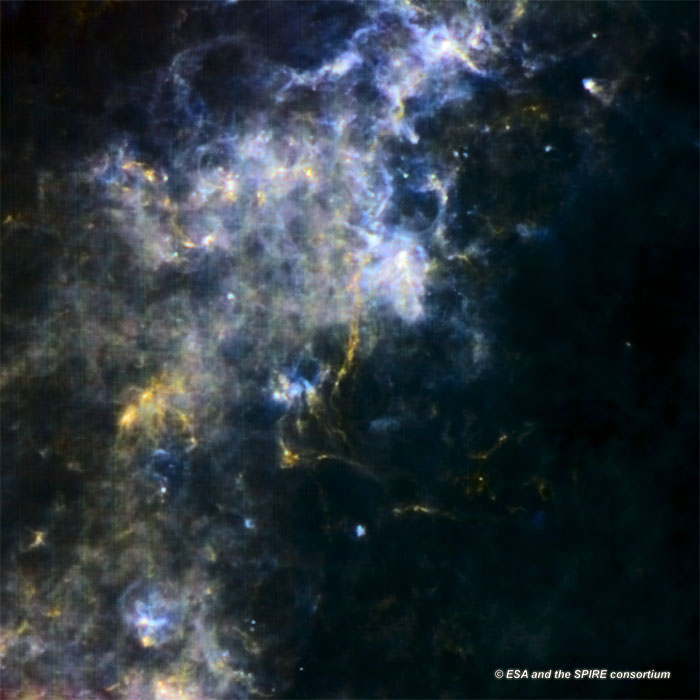
SPIRE infrared image of a reservoir of cold gas in the constellation of the Southern Cross. The region is located about 60° from the Galactic Centre, thousands of light-years from Earth. The images cover an area of 2°x2° on the sky.
The images taken on 3 September reveal structure in cold material in our Galaxy, as we have never seen it before. Even before a detailed analysis, scientists have gleaned information on the quantity of the material, its mass, temperature, composition and whether it is collapsing to form new stars.
That a dark, cool area such as this would be bustling with activity, was unexpected. But the images reveal a surprising amount of turmoil: the interstellar material is condensing into continuous and interconnected filaments glowing from the light emitted by new-born stars at various stages of development. Ours is a tireless Galaxy constantly forging new generations of stars.
Stars form in cold, dense environments, and in these images it is easy to locate the star-forming filaments that would be very difficult to isolate in a single-wavelength image.
Traditionally, in a crowded region like this, situated in the plane of our Galaxy and containing many molecular clouds along the line of sight, astronomers have had a difficult time resolving details. But Herschel’s sophisticated infrared instruments made short work of the task, seeing through the dust that is opaque to visible light, and seeing the glow from the dust itself. These observations are not possible from ground.
The result is a view of an incredible network of filamentary structures, and features indicating a chain of near-simultaneous star-formation events, glittering like strings of pearls deep in our Galaxy.
The image was constructed by colour-coding the different observing wavelengths, and creating composite false-colour images. Cyan denotes 70 microns and red 160 microns emission.
-
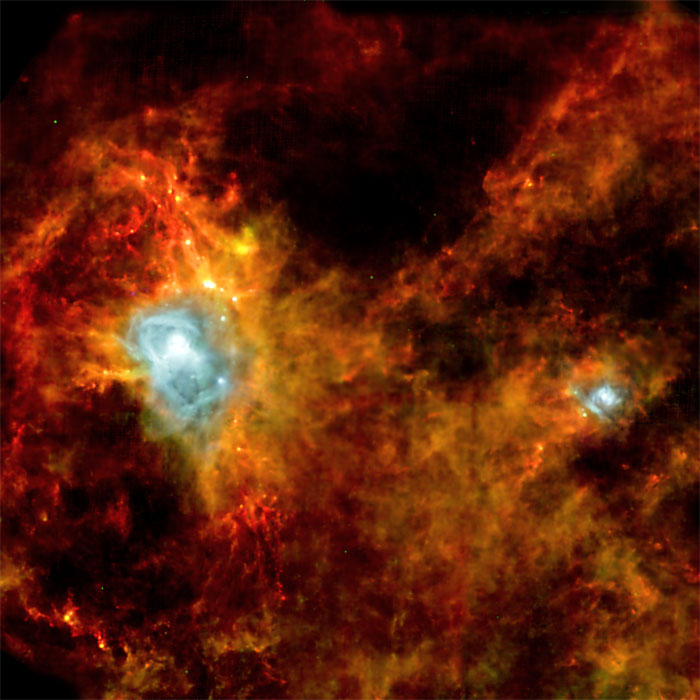
An unseen stellar nursery comes into view in this Herschel image. Some 700 newly-forming stars are estimated to be crowded into these colourful filaments of dust. The complex is part of a mysterious ring of stars called Gould’s Belt.
This image shows a dark cloud 1000 light-years away in the constellation Aquila, the Eagle. It covers an area 65 light-years across and is so shrouded in dust that no previous infrared satellite has been able to see into it. Now, thanks to Herschel’s superior sensitivity at the longest wavelengths of infrared, astronomers have their first picture of the interior of this cloud.
It was taken on 24 October 2009 using two of Herschel’s instruments: the Photodetector Array Camera and Spectrometer (PACS) and the Spectral and Photometric Imaging Receiver (SPIRE). The two bright regions are areas where large newborn stars are causing hydrogen gas to shine.
Embedded within the dusty filaments are 700 condensations of dust and gas that will eventually become stars. Astronomers estimate that about 100 are protostars, celestial objects in the final stages of formation. Each one just needs to ignite nuclear fusion in its core to become a true star. The other 600 objects are insufficiently developed to be considered protostars, but these too will eventually become another generation of stars.
This cloud is part of Gould’s Belt, a giant ring of stars that circles the night sky – the Solar System just happens to lie near the centre of the belt. For more than a hundred years, astronomers have puzzled over the origin of this ring, which is tilted to the Milky Way by 20º. The first to notice this unexpected alignment, in the mid-19th century, was England’s John Herschel, the son of William, after whom ESA’s Herschel telescope is named. But it was Boston-born Benjamin Gould who brought the ring to wider attention in 1874.
Gould’s Belt supplies bright stars to many constellations such as Orion, Scorpius and Crux, and conveniently provides nearby star-forming locations for astronomers to study. Observing these stellar nurseries is a key programme for Herschel, which aims to uncover the demographics of star formation and its origin, or in other words, the quantities of stars that can form and the range of masses that such newborn stars can possess. Apart from this region of Aquila, Herschel will target 14 other star-forming regions as part of the Gould’s Belt Key Programme.
-
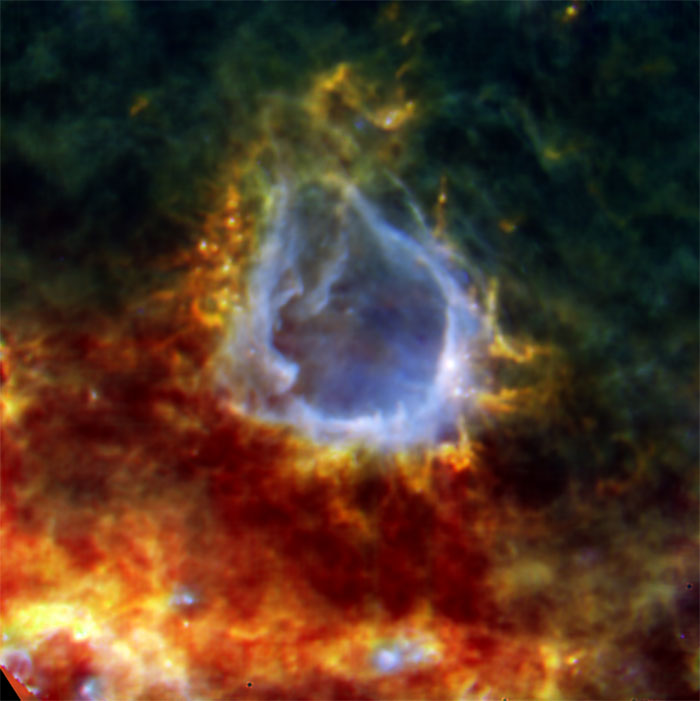
RCW 120 is a galactic bubble with a large surprise. How large? At least 8 times the mass of the Sun. Nestled in the shell around this large bubble is an embryonic star that looks set to turn into one of the brightest stars in the Galaxy.
The Galactic bubble is known as RCW 120. It lies about 4300 light-years away and has been formed by a star at its centre. The star is not visible at these infrared wavelengths but pushes on the surrounding dust and gas with nothing more than the power of its starlight. In the 2.5 million years the star has existed. It has raised the density of matter in the bubble wall so much that the quantity trapped there can now collapse to form new stars.
The bright knot to the right of the base of the bubble is an unexpectedly large, embryonic star, triggered into formation by the power of the central star. Herschel’s observations have shown that it already contains between 8-10 times the mass of our Sun. The star can only get bigger because it is surrounded by a cloud containing an additional 2000 solar masses.
Not all of that will fall onto the star, even the largest stars in the Galaxy do not exceed 150 solar masses. But the question of what stops the matter falling onto the star is a puzzle for modern astronomers. According to theory, stars should stop forming at about 8 solar masses. At that mass they should become so hot that they shine powerfully at ultraviolet wavelengths.
This light should push the surrounding matter away, much as the central star did to form this bubble. But clearly sometimes this mass limit is exceeded otherwise there would be no giant stars in the Galaxy. So astronomers would like to know how some stars can seem to defy physics and grow so large. Is this newly discovered stellar embryo destined to grow into a stellar monster? At the moment, nobody knows but further analysis of this Herschel image could give us invaluable clues.
-
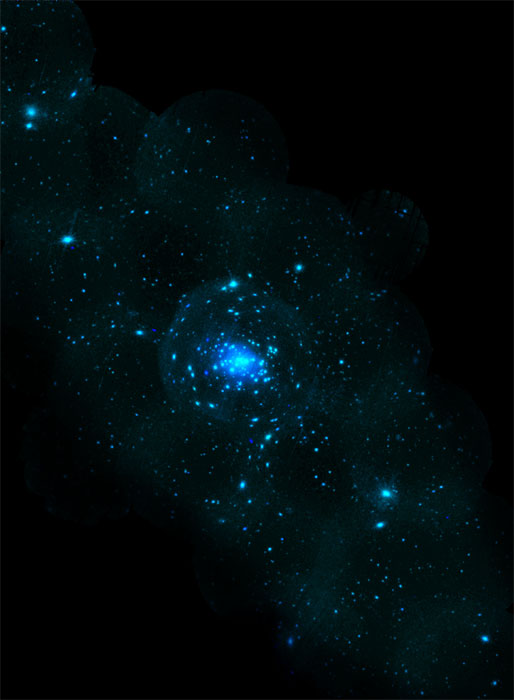
This image of the Andromeda Galaxy was taken by XMM-Newton during Christmas 2010. It shows hundreds of X-ray sources within Andromeda, many of them clustered around the centre, where the stars are densest. Each one is a dying star system. The sources can be shockwaves and debris rolling through space from exploded stars or pairs of stars locked in a gravitational fight to the death, in which one strips the other of precious gas.
-
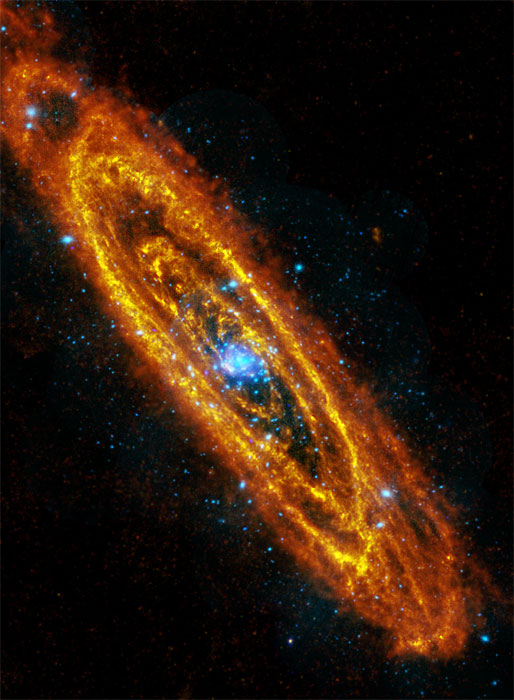
Herschel’s infrared image of the Andromeda Galaxy shows rings of dust that trace gaseous reservoirs where new stars are forming and XMM-Newton’s X-ray image shows stars approaching the ends of their lives. Both infrared and X-ray images convey information impossible to collect from the ground because these wavelengths are absorbed by Earth’s atmosphere.
-

Dense filaments of gas in the IC5146 interstellar cloud. This image was taken by ESA’s Herschel space observatory at infrared wavelengths 70, 250 and 500 microns. Stars are forming along these filaments.
-
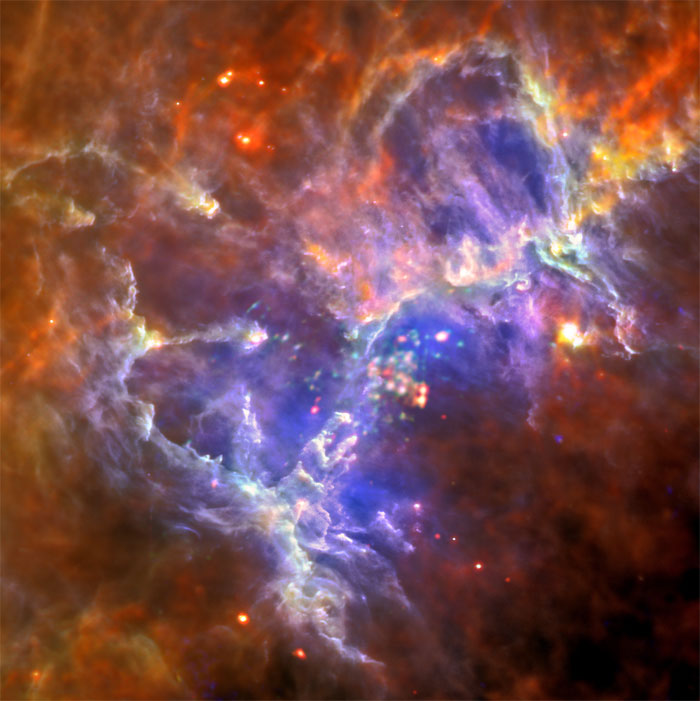
Combining almost opposite ends of the electromagnetic spectrum, this composite of the Herschel in far-infrared and XMM-Newton’s X-ray images shows how the hot young stars detected by the X-ray observations are sculpting and interacting with the surrounding ultra-cool gas and dust, which, at only a few degrees above absolute zero, is the critical material for star formation itself. Both wavelengths would be blocked by Earth’s atmosphere, so are critical to our understanding of the lifecycle of stars
-
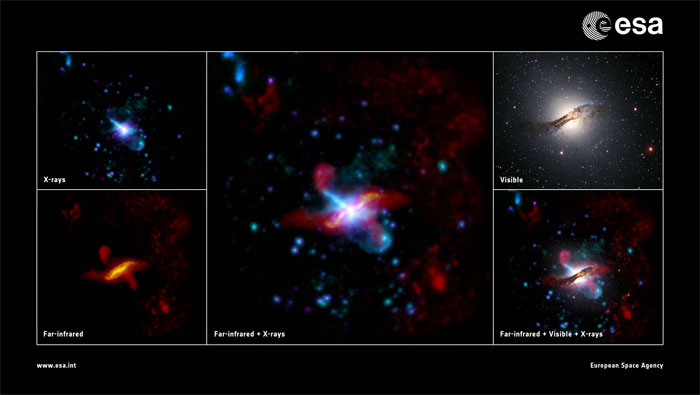
The component images that make up this new multi-wavelength composite of Centaurus A. Clear correlation is seen between the jet features at far-infrared wavelengths and how they interact with their surroundings in the visible light view from the Very Large Telescope of the European Southern Observatory.
-
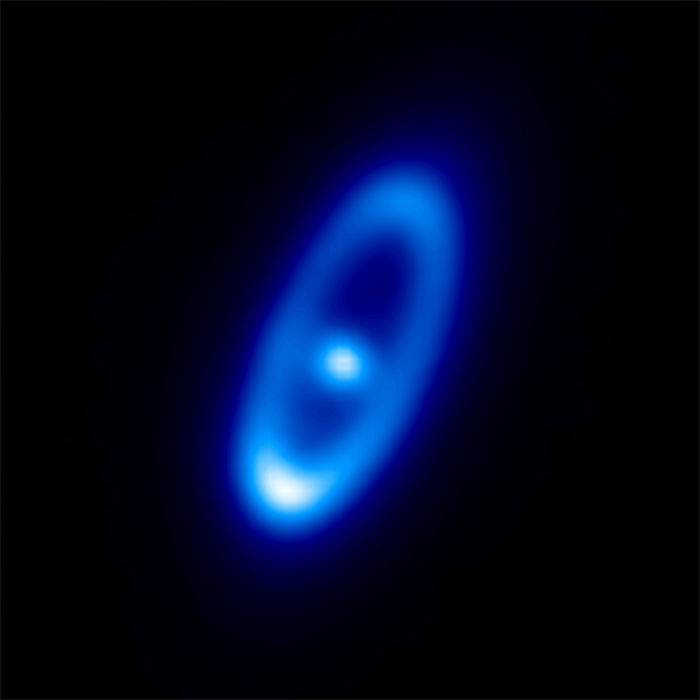
This image shows the infrared emission from the young star Fomalhaut and the dust disc surrounding it, as recorded with ESA's Herschel Space Observatory at a wavelength of 70 micron. To explain the emission from Fomalhaut's debris disc, astronomers invoke a steady production of dust particles via comet collisions, with an average rate of 2000 daily collisions between comets of one kilometre across or, alternatively, of 2 daily collisions between 10-kilometre-diameter comets.
-
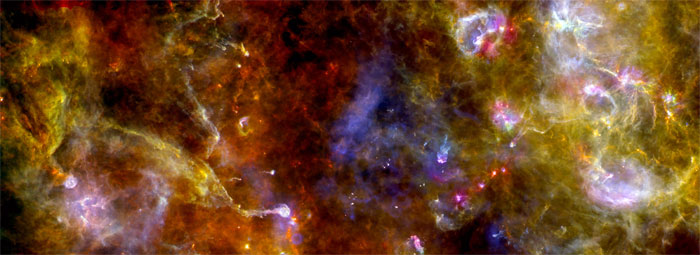
This new view of the Cygnus-X star-formation region by Herschel highlights chaotic networks of dust and gas that point to sites of massive star formation.
The image combines data acquired with the PACS instrument at 70 micron (corresponding to the blue channel) and 160 micron (corresponding to the green channel) and with the SPIRE instrument at 250 micron (corresponding to the red channel). The observations were made on 24 May 2010 and 18 December 2010. North is to the lower-right and east to the upper-right.
-
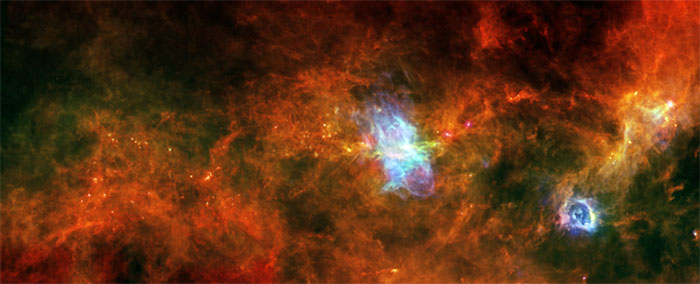
The Vela C region, part of the Vela complex, by ESA’s Herschel space observatory. The image demonstrates Herschel’s ability to trace both high- and low-mass star formation at a range of evolutionary stages, from cool filaments, pre-stellar cores and protostars to more evolved regions containing dust that has been gently heated by hot stars.
The image was mapped using Herschel instruments PACS and SPIRE at wavelengths of 70, 160, and 250 microns, corresponding to the blue, green and red channels, respectively. North is to the right and east is up.
-
Fotos: ESA
7152 Views
